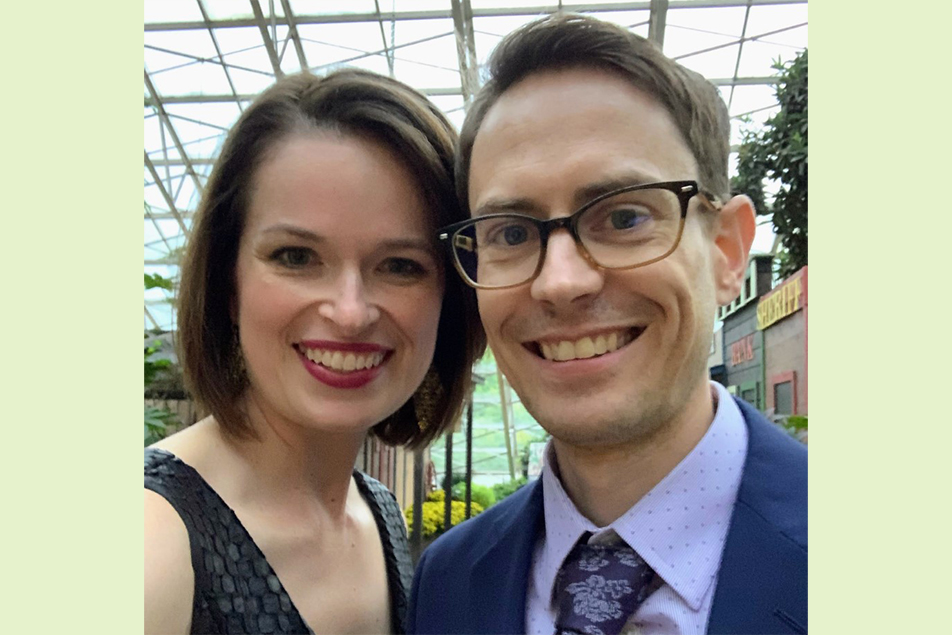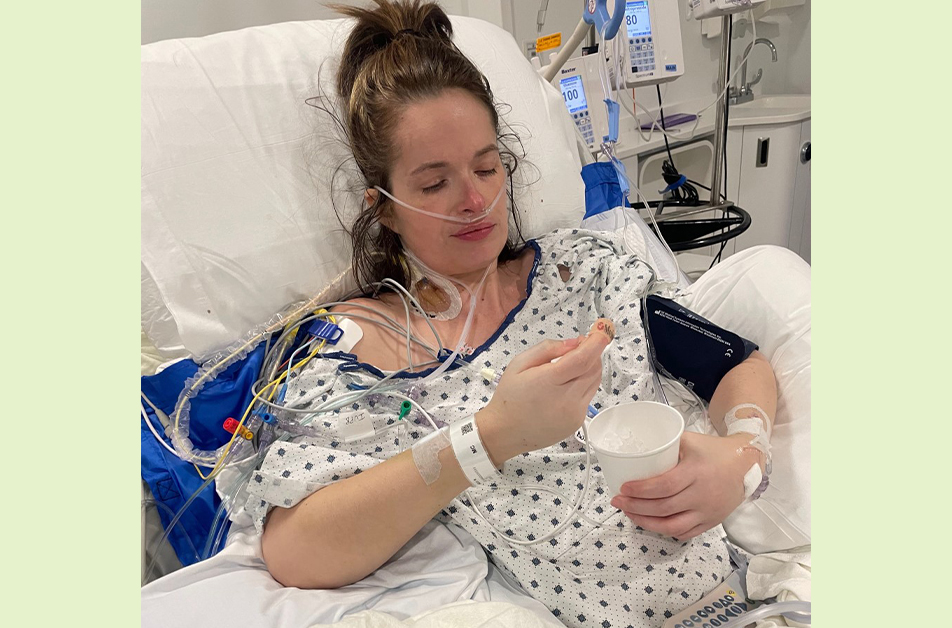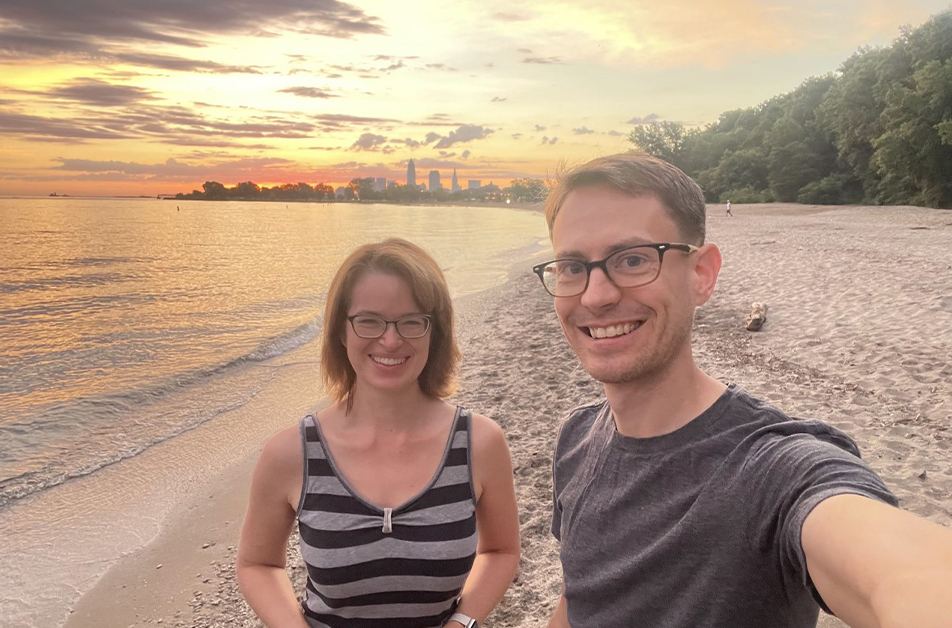
Earlier this year, a young woman found herself in a frightening health crisis that took her on an unbelievable journey. Read on as she shares her unique story with us and the exceptional care she received.
Emily Liechty, 39, is an Upstate New York native who relocated to Indiana in her twenties. A fact that when shared with others is almost always followed by one question, “Why did you move to the Hoosier State?”
“It is one of the best decisions I have ever made,” she said. “Indiana is where I completed my undergraduate degree, it is the state that provided a home base for me so I could explore the world, and it is where I met my husband, Michael.”
Emily is a licensed clinical social worker at a private practice. In her spare time, she enjoys reading, experimenting in the garden, cooking, trying new foods, hiking, and planning the next adventure with her husband.
Emily’s health journey
Despite being relatively healthy, Emily began experiencing flu-like symptoms earlier this year. At her husband’s urging, and with her own gut telling her to do so, she went to the Parkview Walk-In Clinic for an evaluation in January.
“I was hit in the first wave of COVID-19 when the virus entered the U.S.,” she explained. “I caught it again in November 2020. Neither case required hospitalization, but my body took a beating, so I was first in line as soon as the vaccination and boosters were available. Still, COVID found me again, even after receiving my booster. At first, it seemed this episode would be mild. I even felt better for a few days, but then the exhaustion hit. My body hurt, and my heart began fluttering. It was hard to keep my eyes open.”
During her visit to the walk-in clinic, Christina Ondercin, NP, noticed something wasn’t quite right and decided to send Emily to the Emergency Department (ED). “I credit her with starting the process that eventually saved my life.”
After several tests in the Parkview Hospital Randallia ED, Emily and her husband were shocked when the physician told them she had a condition called myocarditis, or inflammation of the heart muscle, due to a COVID infection. Following this surprising diagnosis, Emily was transferred and admitted to Parkview Regional Medical Center for further assessment and treatment.
“Upon arrival at the main hospital, my condition continued to worsen,” Emily recalled. “My brain felt tired and disoriented, my eyes were so heavy, and talking became more difficult. My blood pressure and oxygen levels kept dropping and Troponin levels continued to rise. My memories of the day are like fireworks, appearing in bursts and flashes – meeting the comforting nurse, seeing my sister, then my husband appeared. I felt like I was floating in space.”
One of the last co-workers Emily remembers interacting with was her Intensive Care Unit (ICU) nurse Rick Mayer, RN, who helped calm and comfort her as her condition rapidly worsened and her fear heightened. “I am so thankful for Rick. He was upbeat, positive and provided enough information to satisfy my racing brain,” she said. Later, Emily’s care team had to ask her family to leave due to a treatment she needed to receive. “I suddenly realized I could die alone,” Emily said. However, Rick insisted she wouldn’t die and added, “Nobody dies alone in [my] hospital.”

“I also remember one of my doctors had the very difficult task of telling me that I might not survive this,” she said. “I remember trying to tell him, ‘It’s okay. I have fit a lot of life into 39 years.’ The words didn’t come out right that day, but it was true. At that moment, memories flashed one after the other: riding an elephant through the jungles of Nepal in search of a tiger, lying in the grass staring at the Eiffel Tower above me, watching the sunrise over Angkor Wat, and hiking a Norwegian fjord to reach the top of the waterfall. I remembered marrying Michael, my best friend-turned-husband, ten years ago. Life has been amazing, and there isn’t anything I would change.”
The next thing Emily remembered was waking up in a room in the Cardiac ICU of Cleveland Clinic Heart, Vascular and Thoracic Institute. She was surrounded by tubes, wires and machines. She’d been asleep for six days. Slowly, Emily learned the rest of her story from her family and medical staff.
“I am still learning new details to this day, but as the myocarditis worsened, it sent my body into cardiogenic shock,” Emily explained. “Essentially, my heart stopped pumping, depriving my body of blood and oxygen. An interventional cardiologist who was part of my care team at Parkview explained that my chance of survival when originally admitted was extremely low, but they never stopped trying. Daniel Hugenberg, MD, PPG - Cardiology, decided to use a device, an [Impella® Heart Pump], to allow my heart to rest while the pump did the heavy lifting. Then, they reached out to other hospitals for help, thinking a transplant may be the only way to save my life. The Cleveland Clinic offered to help.”
Emily was airlifted from Parkview to Cleveland for further treatment. As her husband, Michael, anxiously watched the helicopter take off, he was stunned to see her nurse, Rick, pull up beside him in the parking lot. Rick assured Michael that Emily would make it through. “It was exactly what he needed to hear,” she said. In fact, to this day, Emily still refers to Rick as her “hero” for the support and care he provided.
Miraculously, within days of arriving in Cleveland, Emily’s heart showed signs of improvement and that it might be able to beat on its own. Her cardiologists began to wean her heart off the pump to determine if it was strong enough to remove the device. Sure enough, Emily’s heart was working beautifully, and she was able to start down the long road to recovery.
The Cleveland Clinic cardiologists were also astonished at how quickly her overall health improved. Within days, Emily went from bedridden and reliant on nurses to sitting up, then walking with a cane. Seeing her progress, Emily’s doctors ordered an MRI to determine the extent of the damage to her heart. When the results came back, shock filled the room. Her team of cardiologists reported that, incredibly, her heart did not appear to be permanently damaged.
On the path to healing
Emily continues her work with the Parkview Cardiac Rehabilitation team, and her progress is exciting. Her heart is growing stronger daily; she no longer uses a cane and has even returned to work. Emily went on to demonstrate her appreciation for everyone involved in her care with these beautiful words of recognition, “There are numerous nurses and doctors, whose names I will never know, but to whom I owe a large debt of gratitude. From the very start of this journey, every person who took part in my care did their job with excellence. I am here today because of their intelligence, professionalism, intuition and teamwork. Thank you!”
